Numerical Predictions of Low-Reynolds-Number Propeller Aeroacoustics: Comparison of Methods at Different Fidelity Levels †
Abstract
1. Introduction
2. Numerical Methods and Problem Setup
2.1. Flow and Multi-Fidelity Noise Modeling
2.1.1. Flow Modeling
2.1.2. High-Fidelity Noise Modeling Using Ffowcs-Williams and Hawkings Method
2.1.3. Medium-Fidelity Noise Modeling Using Henson’s Method
2.1.4. Low-Fidelity Noise Modeling Using Gutin’s Method
2.2. Demonstration Case Setup
Numerical Setup in Flow Modeling
3. Results
3.1. Propeller Aerodynamics
3.1.1. Aerodynamic Loading
3.1.2. Flow Features
3.2. Far-Field Noise
3.2.1. Tonal Noise
3.2.2. Broadband Noise
3.2.3. Overall Noise
4. Discussion
4.1. On the Mechanism of Noise Generation and Radiation
4.2. On the Capacities of the Three Noise Modeling Methods
- -
- Gutin’s method: Gutin’s method presented considerable accuracy in predicting the magnitudes of the first BPF harmonic in the vertical direction, with difference of 1.55–4.08 dB. The accuracy decreased as the harmonic order increased. This method can be used to roughly estimate the OASPL noise in the vertical direction for cases with similar aeroacoustic features as this work. Gutin’s method is computationally efficient, owing to the tabular calculation and simple inputs required [2]. It uses the propeller blade number, diameter, blade area, and flight speeds to describe the problem setup, and the steady and integral values of the propeller thrust and power as aerodynamics inputs [10]. Therefore, Gutin’s method would be ideal for aircraft conceptional design, where the blade characteristics are not identified, and performed together with low-fidelity flow modeling [2].
- -
- Hanson’s method: Hanson’s method shows good accuracy in predicting tonal noise, in terms of the magnitudes of the blade passing harmonics and the SPL directivity. This method can be used to estimate the OASPL noise in the vertical direction (with a difference of around 2.84 dB) for cases with similar aeroacoustic features to this work, but not in the streamwise direction, where broadband noise dominates. Hanson’s method requires more inputs for computation than Gutin’s method. Additional inputs include propeller blade profiles and relative air angles for the problem setup, as well as the distributions of drag and the lift coefficients as the aerodynamic inputs [14].
- -
- The FWH method: The FWH method presents good accuracy in predicting both tonal noise and broadband noise. The overestimation of sound pressure at high-frequency components and high-order BPF harmonics may be corrected using a finer mesh and longer sampling times. In general, this method is suitable for cases where the broadband noise is significant with respect to the overall propeller noise. On the other hand, the FWH method is much more computationally intensive, four- and three-orders, respectively, higher than Gutin’s and Hanson’s methods. It needs to be performed together with high-fidelity flow modeling. Spacial and temporal flow solutions are required as the aerodynamics inputs, the amount of which are proportional to the mesh number of the FWH integral surfaces and the sampling time step number [16].
5. Conclusions
Author Contributions
Funding
Data Availability Statement
Acknowledgments
Conflicts of Interest
Abbreviations
| UAV | Unmanned aerial vehicles |
| FWH | Ffowcs-Williams and Hawkings |
| CAA | Computational Aeroacoustics |
| CFD | Computational Fluid Dynamics |
| LES | Large Eddy Simulations |
| WALE | Wall-Adapting Local Eddy-viscosity |
| ESDU | Engineering Sciences Data Unit |
| NRBC | Non-reflective boundary condition |
| BPF | Blade passing frequency |
| SPL | Sound pressure level |
| OASPL | Overall sound pressure level |
| PSD | Power spectral density |
Nomenclature
| reference sound speed | |
| D | propeller diameter |
| dt | time step |
| E | total energy |
| f | frequency |
| P | propeller pitch |
| p | pressure |
| q | heat flux |
| density | |
| T | propeller thrust |
| Q | propeller toque |
| direction angle of acoustic far-field | |
| dimensionless wall unit |
References
- Baledón, M.S.; Kosoy, N. “Problematizing” carbon emissions from international aviation and the role of alternative jet fuels in meeting ICAO’s mid-century aspirational goals. J. Air Transp. Manag. 2018, 71, 130–137. [Google Scholar] [CrossRef] [PubMed]
- Guynn, M.D.; Berton, J.J.; Haller, W.J.; Hendricks, E.S.; Tong, M.T. Performance and Environmental Assessment of an Advanced Aircraft with Open Rotor Propulsion; Technical Report; NASA: Washington, DC, USA, 2012.
- Silva, C.; Johnson, W.R.; Solis, E.; Patterson, M.D.; Antcliff, K.R. VTOL urban air mobility concept vehicles for technology development. In Proceedings of the 2018 Aviation Technology, Integration, and Operations Conference, Atlanta, GA, USA, 25–29 June 2018; p. 3847. [Google Scholar]
- Kurtz, D.; Marte, J. A Review of Aerodynamic Noise from Propellers, Rotors, and Lift Fans; NASA: Washington, DC, USA, 1970.
- Schlegel, R.; King, R.; Mull, H. Helicopter Rotor Noise Generation and Propagation; Citeseer: Alexandria, VA, USA, 1966. [Google Scholar]
- Lowson, M.; Ollerhead, J. A theoretical study of helicopter rotor noise. J. Sound Vib. 1969, 9, 197–222. [Google Scholar] [CrossRef]
- Wright, S. The acoustic spectrum of axial flow machines. J. Sound Vib. 1976, 45, 165–223. [Google Scholar] [CrossRef]
- Farassat, F. Advanced Theoretical Treatment of Propeller Noise; Lecture Series; von Karman Institute for Fluid Dynamics: Sint-Genesius-Rode, Belgium, 1982; pp. 81–82. [Google Scholar]
- Gutin, L. On the Sound Field of a Rotating Propeller; Physikalische Zeitschrit der Sowjetinion: Physical Magazine of the Soviet Union Volume 9 Number 1; NASA: Washington, DC, USA, 1948; Volume 9.
- Aircraft Noise Committee. Estimation of the Maximum Discrete Frequency Noise from Isolated Rotors and Propellers; Technical Report; Tech Rep Aerounautical Series 76020; ESDU: London, UK, 2011.
- Hanson, D.B.; Fink, M.R. The importance of quadrupole sources in prediction of transonic tip speed propeller noise. J. Sound Vib. 1979, 62, 19–38. [Google Scholar] [CrossRef]
- Hanson, D.B. Helicoidal surface theory for harmonic noise of propellers in the far field. AIAA J. 1980, 18, 1213–1220. [Google Scholar] [CrossRef]
- Hanson, D.B.; Parzych, D.J. Theory for Noise of Propellers in Angular Inflow with Parametric Studies and Experimental Verification; Technical Report; NASA: Washington, DC, USA, 1993.
- Aircraft Noise Committee. Prediction of Near-Field and Far-Field Harmonic Noise from Subsonic Propellers with Non-Axial Inflow; Technical Report; Tech Rep Aerounautical Series 11005; ESDU: London, UK, 2018.
- Peake, N.; Parry, A.B. Modern challenges facing turbomachinery aeroacoustics. Annu. Rev. Fluid Mech. 2012, 44, 227–248. [Google Scholar] [CrossRef]
- Lele, S.K.; Nichols, J.W. A second golden age of aeroacoustics? Philos. Trans. R. Soc. A Math. Phys. Eng. Sci. 2014, 372, 20130321. [Google Scholar] [CrossRef] [PubMed]
- Huang, G.; Sharma, S.; Ambrose, S.; Jefferson-Loveday, R. Numerical study on the aeroacoustics of a propeller-wing integration at various advance ratios. In Proceedings of the Turbo Expo: Power for Land, Sea, and Air; American Society of Mechanical Engineers: Houston, TX, USA, 2023; Volume 86939, p. V001T01A024. [Google Scholar]
- Huang, D.; Yang, Z.; Leung, R.C.K. Implementation of direct acoustic simulation using ANSYS Fluent. In Proceedings of the INTER-NOISE and NOISE-CON Congress and Conference Proceedings, Washington, DC, USA, 1–5 August 2021; Institute of Noise Control Engineering: Wakefield, MA, USA, 2021; Volume 263, pp. 1243–1252. [Google Scholar]
- Sharma, S.; Huang, G.; Ambrose, S.; Jefferson-Loveday, R. Numerical study on the aeroacoustics and interaction of two distributed-propulsion propellers in co-and counter-rotations. Proc. Mtgs. Acoust. 2022, 50, 030002. [Google Scholar]
- Kotwicz Herniczek, M.T.; Feszty, D.; Meslioui, S.A.; Park, J.; Nitzsche, F. Evaluation of acoustic frequency methods for the prediction of propeller noise. AIAA J. 2019, 57, 2465–2478. [Google Scholar] [CrossRef]
- Bergmann, O.; Möhren, F.; Braun, C.; Janser, F. Comparison of Various Aeroacoustic Propeller Noise Prediction Methodologies in Static Operations. In Proceedings of the AIAA SciTech 2022 Forum, San Diego, CA, USA, 3–7 January 2022; p. 2529. [Google Scholar]
- Candeloro, P.; Ragni, D.; Pagliaroli, T. Small-scale rotor aeroacoustics for drone propulsion: A review of noise sources and control strategies. Fluids 2022, 7, 279. [Google Scholar] [CrossRef]
- Huang, G.; Sharma, A.; Chen, X.; Riaz, A.; Jefferson-Loveday, R. Framework for Multi-Fidelity Assessment of Open Rotor Propeller Aeroacoustics. In Proceedings of the 30th AIAA/CEAS Aeroacoustics Conference (2024), Roma, Italy, 4–7 June 2024; p. 3098. [Google Scholar]
- Lighthill, M.J. On sound generated aerodynamically I. General theory. Proc. R. Soc. Lond. Ser. A Math. Phys. Sci. 1952, 211, 564–587. [Google Scholar]
- Huang, G.; Sharma, S.; Ambrose, S.; Jefferson-Loveday, R. Numerical Prediction of Aerodynamic Noise for a Propeller-wing Configuration and an Investigation of Pitch Effect. In Proceedings of the INTER-NOISE and NOISE-CON Congress and Conference Proceedings, Institute of Noise Control Engineering, Tokyo, Japan, 20–23 August 2023; Volume 268, pp. 7475–7486. [Google Scholar]
- Ffowcs Williams, J.E.; Hawkings, D.L. Sound generation by turbulence and surfaces in arbitrary motion. Philos. Trans. R. Soc. Lond. Ser. A Math. Phys. Sci. 1969, 264, 321–342. [Google Scholar]
- Jamaluddin, N.S.; Celik, A.; Baskaran, K.; Rezgui, D.; Azarpeyvand, M. Experimental characterisation of small-scaled propeller-wing interaction noise. In Proceedings of the 28th AIAA/CEAS Aeroacoustics 2022 Conference, Southampton, UK, 14–17 June 2022; p. 2973. [Google Scholar]
- Turhan, B.; Kamliya Jawahar, H.; Bowen, L.; Rezgui, D.; Azarpeyvand, M. Aeroacoustic characteristics of distributed electric propulsion system in forward flight. In Proceedings of the AIAA AVIATION 2023 Forum, San Diego, CA, USA, 12–16 June 2023; p. 4490. [Google Scholar]
- Lee, D.; Kawai, S.; Nonomura, T.; Anyoji, M.; Aono, H.; Oyama, A.; Asai, K.; Fujii, K. Mechanisms of surface pressure distribution within a laminar separation bubble at different Reynolds numbers. Phys. Fluids 2015, 27, 023602. [Google Scholar] [CrossRef]
- Thompson, M.C. Effective transition of steady flow over a square leading-edge plate. J. Fluid Mech. 2012, 698, 335–357. [Google Scholar] [CrossRef]
- Williams, J.F.; Hall, L. Aerodynamic sound generation by turbulent flow in the vicinity of a scattering half plane. J. Fluid Mech. 1970, 40, 657–670. [Google Scholar] [CrossRef]


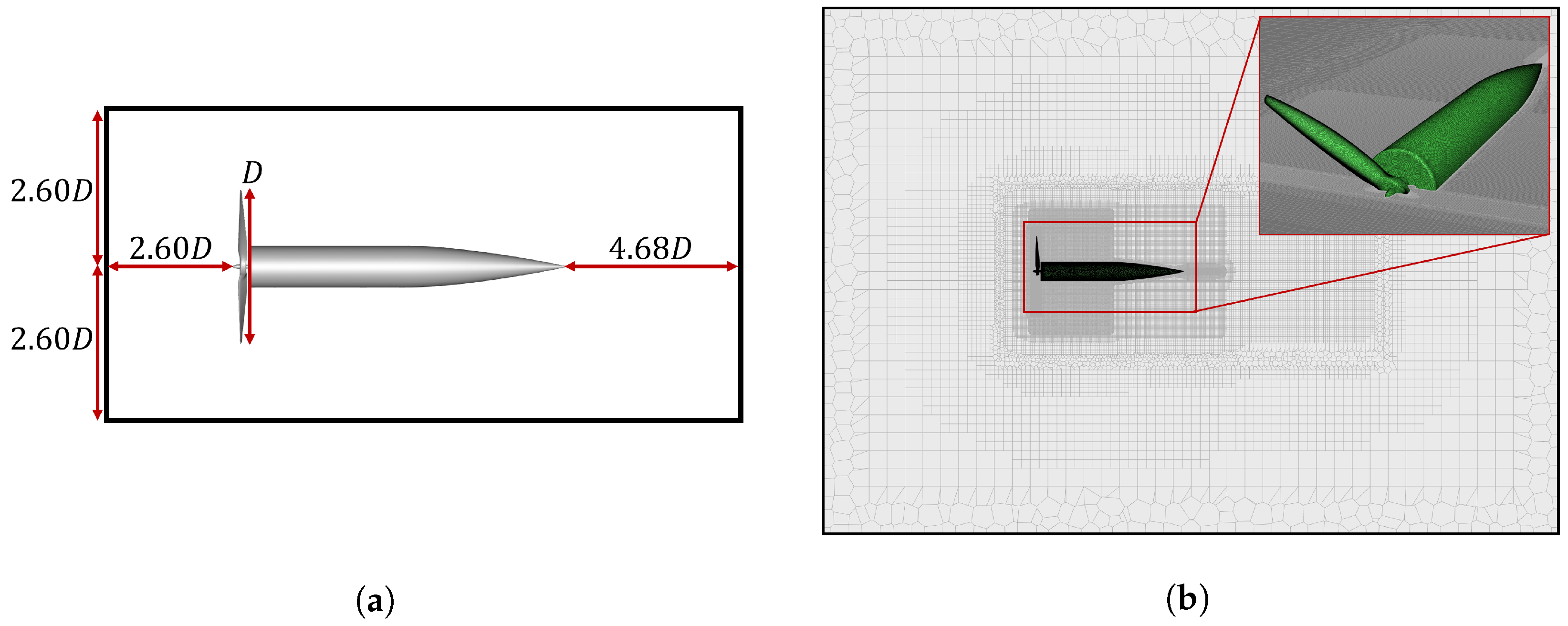
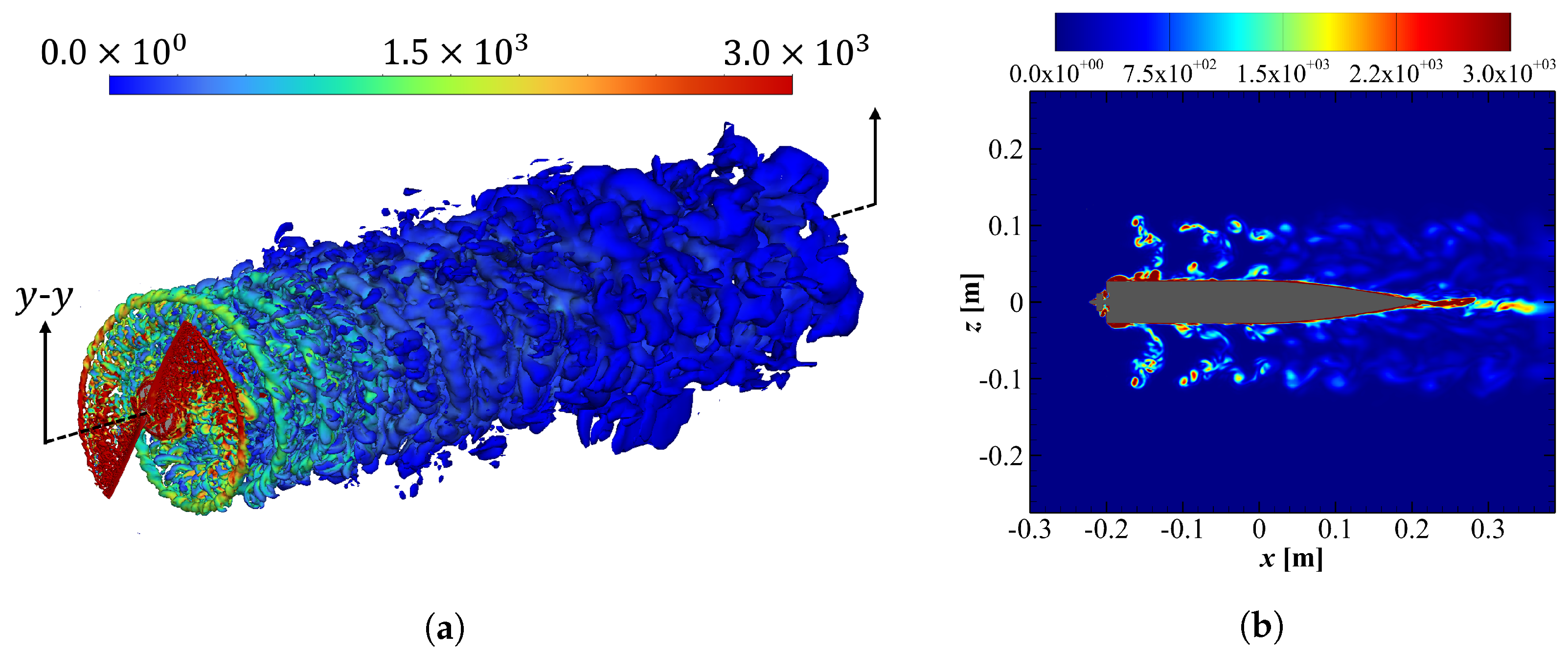


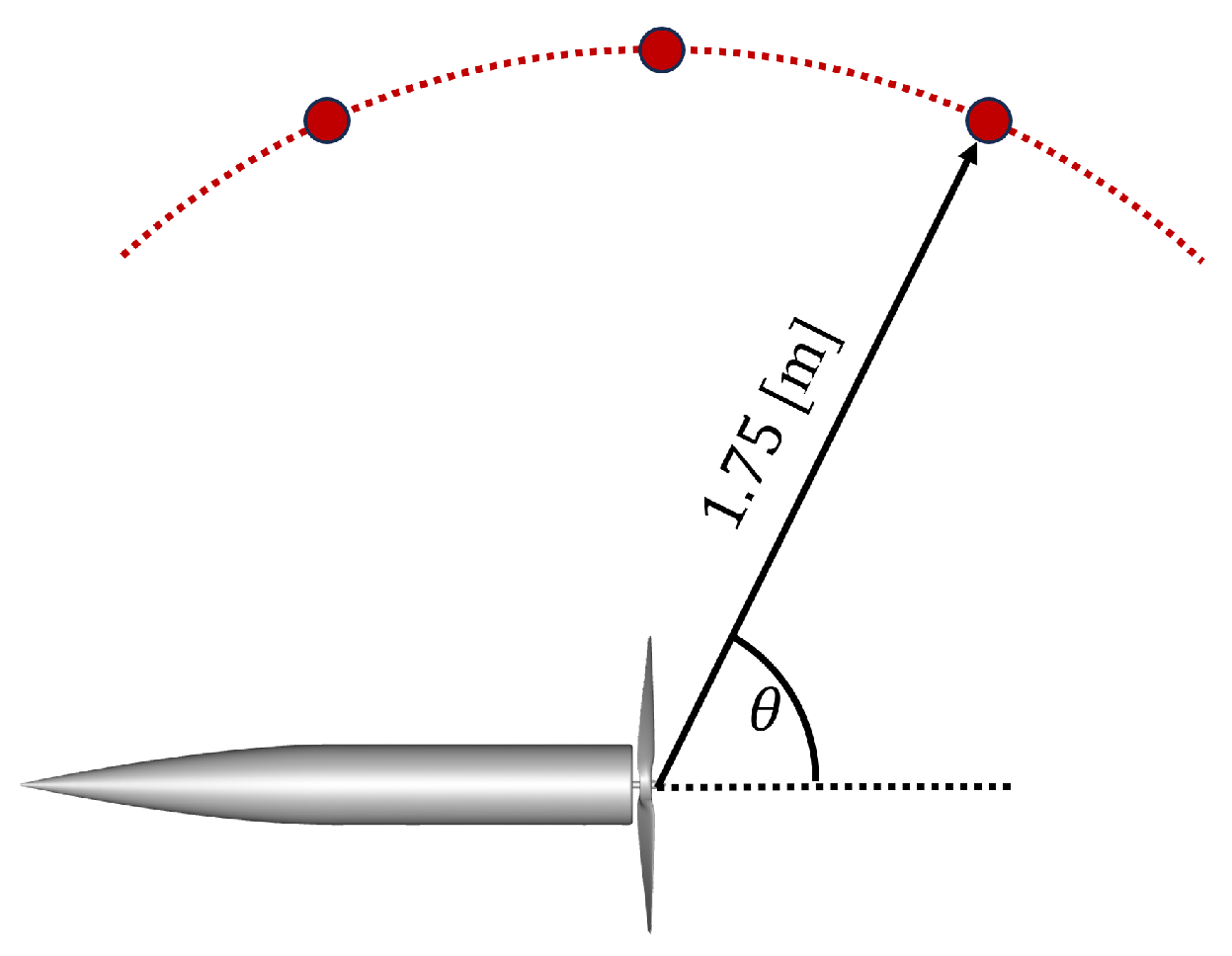
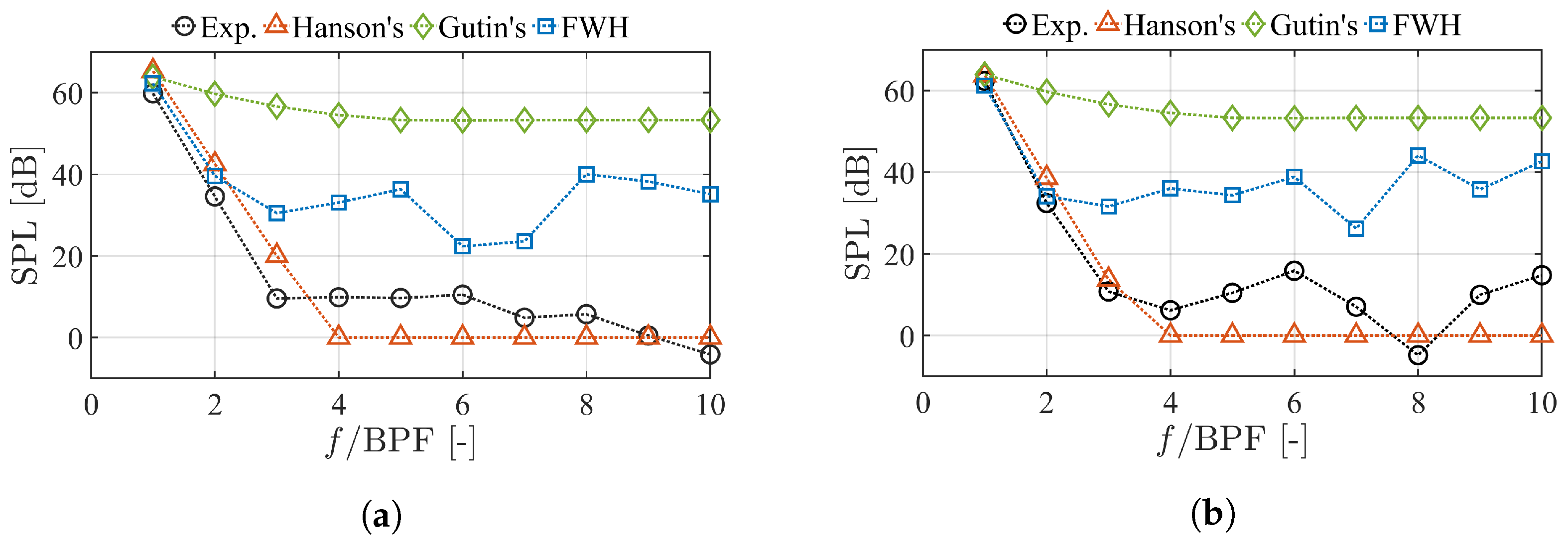
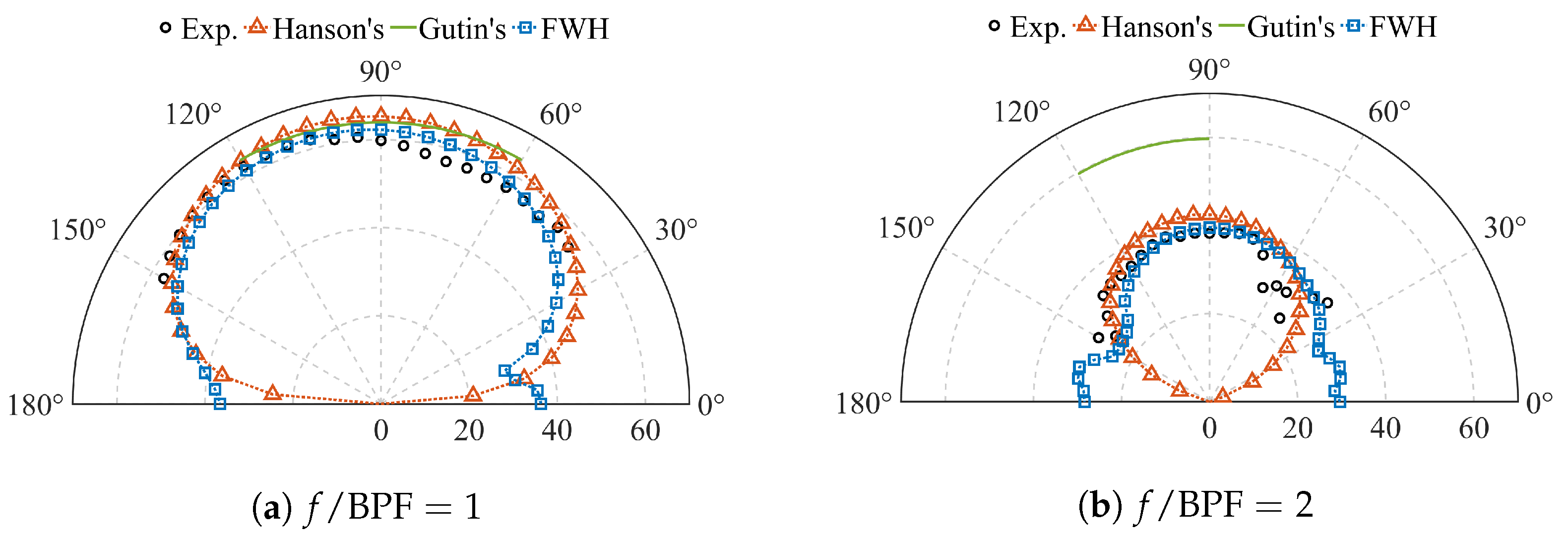

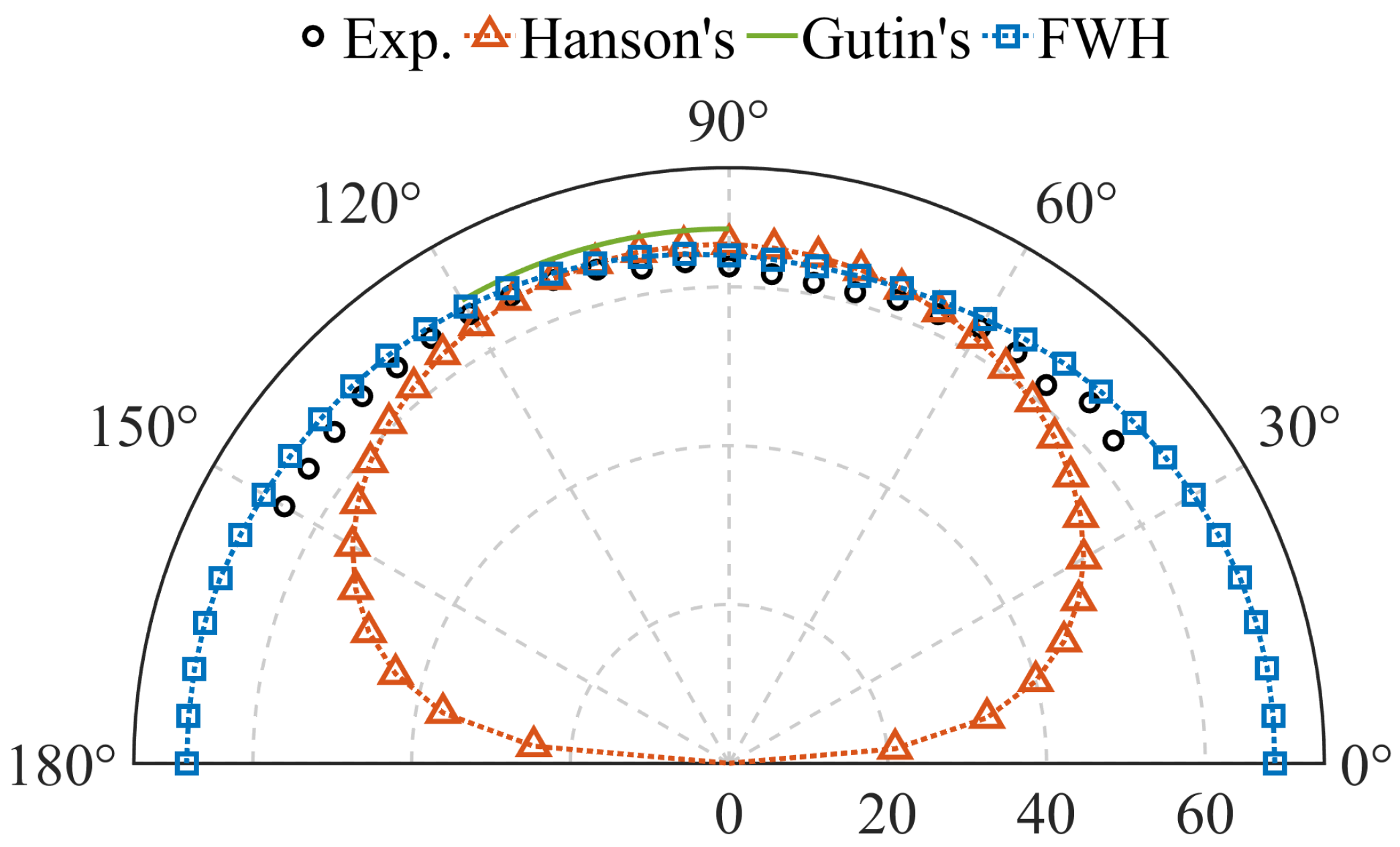
| Present (LES) | Experiment * | Difference | |
|---|---|---|---|
| [N] | 2.9205 | 2.8197 | |
| [N·m] | 0.0964 | 0.0976 |
| Acoustic Model | BPF Tone | Higher Harmonics | Broadband Noise | Noise Directivity | Computational Time Factor |
|---|---|---|---|---|---|
| Gutin’s | Good | Poor | n/a | n/a | 1 |
| Hanson’s | Good | Good | n/a | Poor | |
| FWH | Good | Fair | Good | Good |
Disclaimer/Publisher’s Note: The statements, opinions and data contained in all publications are solely those of the individual author(s) and contributor(s) and not of MDPI and/or the editor(s). MDPI and/or the editor(s) disclaim responsibility for any injury to people or property resulting from any ideas, methods, instructions or products referred to in the content. |
© 2025 by the authors. Licensee MDPI, Basel, Switzerland. This article is an open access article distributed under the terms and conditions of the Creative Commons Attribution (CC BY) license (https://creativecommons.org/licenses/by/4.0/).
Share and Cite
Huang, G.; Sharma, A.; Chen, X.; Riaz, A.; Jefferson-Loveday, R. Numerical Predictions of Low-Reynolds-Number Propeller Aeroacoustics: Comparison of Methods at Different Fidelity Levels. Aerospace 2025, 12, 154. https://doi.org/10.3390/aerospace12020154
Huang G, Sharma A, Chen X, Riaz A, Jefferson-Loveday R. Numerical Predictions of Low-Reynolds-Number Propeller Aeroacoustics: Comparison of Methods at Different Fidelity Levels. Aerospace. 2025; 12(2):154. https://doi.org/10.3390/aerospace12020154
Chicago/Turabian StyleHuang, Guangyuan, Ankit Sharma, Xin Chen, Atif Riaz, and Richard Jefferson-Loveday. 2025. "Numerical Predictions of Low-Reynolds-Number Propeller Aeroacoustics: Comparison of Methods at Different Fidelity Levels" Aerospace 12, no. 2: 154. https://doi.org/10.3390/aerospace12020154
APA StyleHuang, G., Sharma, A., Chen, X., Riaz, A., & Jefferson-Loveday, R. (2025). Numerical Predictions of Low-Reynolds-Number Propeller Aeroacoustics: Comparison of Methods at Different Fidelity Levels. Aerospace, 12(2), 154. https://doi.org/10.3390/aerospace12020154








